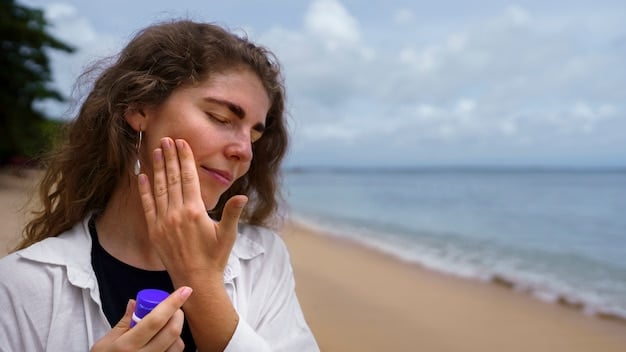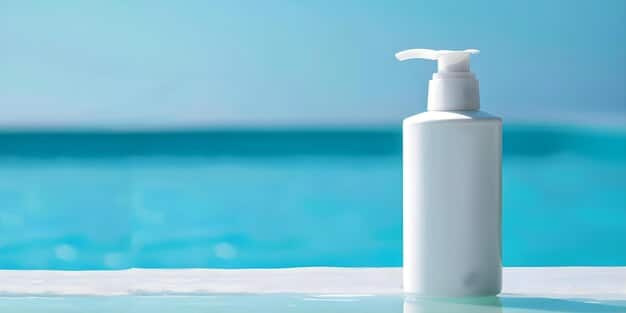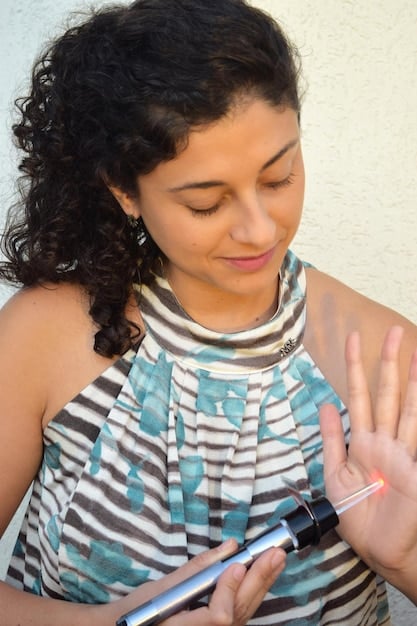Sunscreen 101: Your Guide to Choosing the Right SPF

Sunscreen 101: Choosing the Right SPF and Incorporating It Into Your Daily Routine involves understanding SPF numbers, broad-spectrum protection, application techniques, and reapplication frequency to effectively shield skin from harmful UV rays and prevent sun damage.
Navigating the world of sunscreen can feel overwhelming, but understanding its importance is crucial for protecting your skin. This guide, **Sunscreen 101: Choosing the Right SPF and Incorporating It Into Your Daily Routine**, will simplify everything you need to know about selecting and using sunscreen effectively.
Understanding SPF: What Does It Really Mean?
The sun protection factor (SPF) is a measure of how well a sunscreen protects your skin from UVB rays, the kind of radiation that causes sunburn, skin damage, and can contribute to skin cancer. SPF values range from 15 to 100, but what do these numbers actually signify?
Let’s break down the meaning behind SPF numbers to help you make informed decisions.
Decoding SPF Numbers
SPF isn’t a direct indication of the amount of time you can stay in the sun without burning. Instead, it represents the fraction of UVB rays that reach your skin. For example:
- SPF 15: Blocks approximately 93% of UVB rays.
- SPF 30: Blocks approximately 97% of UVB rays.
- SPF 50: Blocks approximately 98% of UVB rays.
While the difference between SPF 30 and SPF 50 might seem small, those percentages can make a significant impact over prolonged sun exposure. It’s important to note that no sunscreen blocks 100% of UVB rays.
The Right SPF for Your Skin
The American Academy of Dermatology recommends using a broad-spectrum sunscreen with an SPF of 30 or higher daily.
- Daily Use: SPF 30 is generally sufficient for everyday activities where sun exposure is moderate.
- Prolonged Exposure: If you’re spending extended periods outdoors, especially during peak sun hours (10 AM to 4 PM), SPF 50 or higher is advisable.
- Fair Skin: Individuals with fair skin or a history of skin cancer should opt for higher SPF values.
Choosing the right SPF depends on your skin type, the intensity of the sun, and the duration of exposure. Don’t assume a higher SPF allows you to stay in the sun longer without reapplying; regular reapplication is essential regardless of the SPF level.
Understanding SPF is the first step in protecting your skin. Remember, consistency and proper application are just as vital as the SPF number itself. Protecting your skin every day is like wearing a shield that adds another layer of defense to keep it healthy and youthful.
Broad-Spectrum Protection: Why It Matters
While SPF focuses on UVB rays, it’s equally important to protect your skin from UVA rays. These rays penetrate deeper into the skin, contributing to premature aging, wrinkles, and an increased risk of skin cancer.
This is where broad-spectrum protection comes in.
UVA vs. UVB Rays
To fully understand the importance of broad-spectrum protection, let’s differentiate between UVA and UVB rays:
- UVB Rays: Primarily responsible for sunburn and play a significant role in the development of skin cancer. They are most intense between 10 AM and 4 PM.
- UVA Rays: Penetrate deeper into the skin and cause long-term damage like premature aging and wrinkles. They are present all day long, regardless of the season.
Both UVA and UVB rays can damage your skin, making it essential to use a sunscreen that protects against both.

How to Identify Broad-Spectrum Sunscreens
Broad-spectrum sunscreens are formulated to protect against both UVA and UVB rays. Look for the term “broad-spectrum” on the product label.
Key ingredients that provide UVA protection include:
- Zinc Oxide: A mineral sunscreen that provides excellent broad-spectrum protection and is gentle on sensitive skin.
- Titanium Dioxide: Another mineral sunscreen that is effective against both UVA and UVB rays.
- Avobenzone: A chemical sunscreen filter that absorbs UVA rays but can degrade in sunlight unless stabilized with other ingredients.
Choosing a broad-spectrum sunscreen ensures you’re getting comprehensive protection against the full spectrum of harmful UV radiation. This is not just a summer consideration but an all-year-round necessity for maintaining healthy, youthful skin.
The Consequences of Neglecting UVA Protection
Using a sunscreen that only protects against UVB rays leaves your skin vulnerable to the detrimental effects of UVA radiation. Long-term exposure to UVA rays can lead to:
- Premature Aging: UVA rays break down collagen and elastin, leading to wrinkles, fine lines, and sagging skin.
- Sunspots and Hyperpigmentation: UVA exposure can cause uneven skin tone and the formation of sunspots.
- Increased Risk of Skin Cancer: While UVB rays are the primary cause of sunburn, UVA rays also contribute to the development of skin cancer.
Broad-spectrum protection is a critical component of any effective sun care routine. By incorporating these sunscreens into your daily practice, you actively defend against the harms of solar radiation, ensuring your skin remains resilient and radiant for years to come.
Choosing the Right Sunscreen Formula: Mineral vs. Chemical
Sunscreen comes in two primary formulations: mineral and chemical. Both types protect your skin from UV rays, but they work differently and have different pros and cons.
Understanding the distinctions between mineral and chemical sunscreens can help you choose the best option for your needs.
Mineral Sunscreens
Mineral sunscreens, also known as physical sunscreens, contain mineral ingredients like zinc oxide and titanium dioxide. These minerals create a physical barrier on the skin that reflects UV rays.
Here are some key characteristics of mineral sunscreens:
- How They Work: Mineral sunscreens sit on top of the skin and reflect UV rays away from the body.
- Ingredients: Typically contain zinc oxide and titanium dioxide as active ingredients.
- Pros: Generally considered safe for sensitive skin, environmentally friendly, and provide broad-spectrum protection.
One potential drawback of mineral sunscreens is that they can sometimes leave a white cast on the skin, although newer formulations are designed to minimize this effect.
Chemical Sunscreens
Chemical sunscreens contain chemical filters that absorb UV rays and convert them into heat, which is then released from the skin.
- How They Work: Chemical sunscreens absorb UV rays and convert them into heat that is released from the skin.
- Ingredients: Common chemical filters include avobenzone, oxybenzone, and octinoxate.
- Pros: Tend to be lightweight, easily absorbed, and don’t leave a white cast.
However, some chemical filters have raised concerns about potential hormone disruption and environmental impact, leading to debates about their safety.
Making the Right Choice
When choosing between mineral and chemical sunscreens, consider your skin type, sensitivities, and personal preferences.
- Sensitive Skin: Mineral sunscreens are often recommended for sensitive skin due to their gentle nature and lower risk of irritation.
- Environmental Concerns: If you’re concerned about the environmental impact, choose mineral sunscreens with zinc oxide and titanium dioxide, as some chemical filters have been linked to coral reef damage.
- Daily Wear: For daily use, opt for a sunscreen that you find comfortable and easy to apply.
Proper Sunscreen Application: Achieving Full Coverage
Even the best sunscreen won’t be effective if it’s not applied correctly. Proper application is key to achieving full coverage and maximizing sun protection.
Here’s a breakdown of how to apply sunscreen effectively:
How Much Sunscreen to Apply
Most people don’t apply enough sunscreen, which significantly reduces its effectiveness. The general guideline is to use about one ounce (or a shot glass full) of sunscreen to cover your entire body.
Specific application amounts include:
- Face and Neck: About a half-teaspoon.
- Arms and Legs: About one teaspoon per limb.
- Torso: About one ounce for the front and back of your body.
The Right Application Techniques
Apply sunscreen liberally and evenly to all exposed skin, paying attention to often-missed areas such as:
- Ears: Easily forgotten but highly susceptible to sun damage.
- Neck: Both the front and back of your neck.
- Tops of Feet: Particularly important if you’re wearing sandals.
Rub the sunscreen in thoroughly to ensure it’s evenly distributed. If using a mineral sunscreen, take extra care to blend it in to minimize any white cast.

When to Apply
Sunscreen should be applied at least 15 to 30 minutes before sun exposure.
- Before Going Outside: Apply sunscreen before you leave the house to allow it to bind to your skin properly.
- On Cloudy Days: UV rays can penetrate clouds, so sunscreen is essential even on overcast days.
Remember, sunscreen is a crucial part of your skincare routine, and proper application ensures your skin is adequately protected from the sun’s harmful rays.
Reapplication is Key: Maintaining Protection Throughout the Day
Sunscreen isn’t a one-and-done application. Reapplication is essential to maintain protection, especially during prolonged sun exposure.
Here’s what you need to know about reapplication:
Why Reapply Sunscreen?
Sunscreen can wear off over time due to factors such as sweating, swimming, and toweling off. Additionally, some sunscreen filters can degrade in sunlight, reducing their effectiveness.
Factors affecting sunscreen efficacy:
- Sweating: Physical activity causes sunscreen to wear off as your sweat removes it.
- Swimming: Even water-resistant sunscreens lose effectiveness after prolonged water exposure.
- Toweling Off: Wiping your skin with a towel can remove sunscreen, leaving your skin vulnerable.
How Often to Reapply
The general recommendation is to reapply sunscreen every two hours, or immediately after swimming or sweating.
- Every Two Hours: Reapply at least every two hours, regardless of the SPF level.
- After Swimming or Sweating: Reapply immediately after swimming or sweating heavily, even if the sunscreen is labeled as water-resistant.
Carry a travel-sized sunscreen with you so you can easily reapply throughout the day. Setting a reminder on your phone can help you stay on track with reapplication.
Choosing Water-Resistant Sunscreen
Water-resistant sunscreens are designed to stay effective for a certain period of time while swimming or sweating. However, no sunscreen is completely waterproof.
- Water Resistance Ratings: Sunscreens are typically labeled as water-resistant for either 40 or 80 minutes.
- Reapplication Still Necessary: Even with water-resistant sunscreen, reapplication is essential after the specified time or immediately after toweling off.
By adhering to these reapplication guidelines, you can ensure that your skin remains adequately protected from the sun’s harmful rays throughout the day.
Incorporating Sunscreen Into Your Daily Skincare Routine
Making sunscreen a daily habit is crucial for long-term skin health. Incorporating it into your skincare routine ensures you’re protected from the sun’s harmful rays year-round.
Here’s how to seamlessly integrate sunscreen into your daily routine:
Sunscreen as the Last Step
Apply sunscreen as the final step in your morning skincare routine, after cleansing, toning, and moisturizing.
- After Skincare Products: Sunscreen should be applied after all other skincare products to ensure it can form a protective barrier on your skin.
- Before Makeup: If you wear makeup, apply sunscreen before applying foundation or other cosmetics.
Choosing the Right Formula for Daily Wear
Opt for a lightweight, non-greasy sunscreen that is comfortable to wear under makeup. Many sunscreens are specifically formulated for daily use and won’t clog pores or cause breakouts.
- Lightweight Formulas: Look for sunscreens labeled as “lightweight,” “non-comedogenic,” or “oil-free.”
- Tinted Sunscreens: These can provide a subtle tint and even out skin tone, making them a great alternative to foundation for light coverage.
Choose a product that integrates seamlessly into your daily routine. The easier it is to apply, the more likely you will make it a daily habit.
Year-Round Protection
Sunscreen isn’t just for sunny days; it’s essential year-round.
- UV Rays in Winter: UV rays can penetrate clouds and reflect off snow, making sunscreen just as important in winter as in summer.
- Indoor Exposure: Even indoor environments can expose you to UV rays through windows, so wearing sunscreen daily is a good habit to protect your skin.
| Key Point | Brief Description |
|---|---|
| ☀️Understanding SPF | SPF measures protection against UVB rays; choose SPF 30 or higher. |
| 🛡️Broad-Spectrum | Protects against both UVA and UVB rays; look for “broad-spectrum” on the label. |
| 🧴Application | Apply one ounce of sunscreen 15-30 minutes before sun exposure. |
| 🔄Reapplication | Reapply every two hours, or immediately after swimming or sweating. |
Frequently Asked Questions
▼
SPF stands for Sun Protection Factor. It measures how much UVB radiation, the kind that causes sunburn, a sunscreen can protect against.
▼
Yes, even on cloudy days, harmful UV rays can penetrate through the clouds and damage your skin. It’s important to wear sunscreen daily, regardless of the weather.
▼
Mineral sunscreens use zinc oxide and titanium dioxide to reflect UV rays, while chemical sunscreens absorb UV rays and convert them into heat. Both are effective, but mineral options are often gentler.
▼
You should apply about one ounce (or a shot glass full) of sunscreen to cover your entire body, with a half-teaspoon for the face and neck. Make sure to apply it evenly.
▼
You should reapply sunscreen every two hours, or immediately after swimming or sweating, to maintain adequate protection against the sun’s harmful rays.
Conclusion
Understanding and incorporating **Sunscreen 101: Choosing the Right SPF and Incorporating It Into Your Daily Routine** into your daily routine is an investment in your skin’s long-term health. By choosing the right SPF, understanding broad-spectrum protection, and applying and reapplying sunscreen correctly, you can effectively shield your skin from the sun’s harmful rays and maintain a healthy, youthful complexion.





